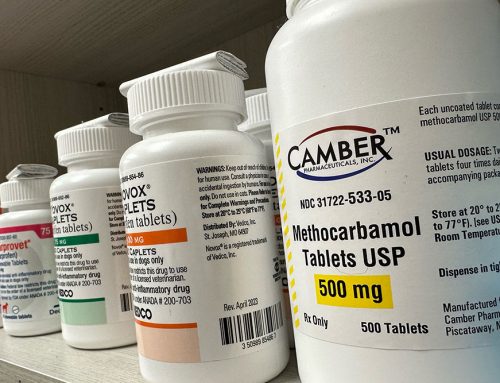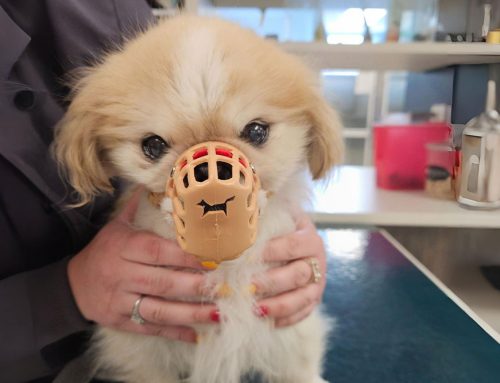Ella is happy to have her pup Lucy back to her playful self.
Happy-go-lucky Lucy gave her family a scare when she started showing signs of pain from her right hind leg. The Australian shepherd mix was only 2 years old and usually very active, but her movements suddenly slowed significantly. She couldn’t put full pressure on her leg, and she was clearly uncomfortable.
When pain medication did nothing to help Lucy return to her exuberant self, Dr. Michelle McDonough took x-rays that showed Lucy’s stifle joint was inflamed, and her exam suggested her cranial cruciate ligament was ruptured. The stifle joint is the equivalent to the human knee. Its job is to join three bones: the femur (upper thigh bone), patella (kneecap) and tibia (shin bone). The cranial cruciate ligament is located between the femur and the tibia and, with the assistance of a few other ligaments, helps hold the two bones stable.

“This is one of the most common orthopedic issues we see,” said Lucy’s veterinarian, Dr. Ellen Reinke. “What I saw in Lucy is among the most common ways the injury shows itself.” Certain large and giant breeds of dog are particularly prone to have these injuries, but overweight dogs are also at higher risk of having cruciate injuries, she said. Cats can get the disease, but it is far less common than in dogs.
The tissue holding the bones together might tear all at once, or it might tear partially until it snaps completely. The condition not only causes pain and lameness, but it also speeds up arthritis. “Unfortunately, roughly half the dogs who experience a rupture in one leg will eventually have the same problem in the other,” said Reinke. “Often that will be within a year of the first tear.”
Dr. Mary Sarah Bergh is a veterinary orthopedic specialist whose clinic – Midwest Veterinary Specialists – partners with Greendale Village Vet. Bergh is a travelling surgeon who uses her orthopedic skills to provide state-of-the art surgeries for Greendale Village Vet patients.

Lucy underwent her surgery in February. Bergh, at right, did a procedure called a tibial plateau leveling ostomy, where she cut the tibia to change the angle of the bone’s surface. “That fixed the instability in the knee,” said Reinke. “Then Dr. Bergh drilled a metal plate into the bone, which stabilized the tibia in its new position.”
Lucy rested the remainder of her surgery day at the clinic, but Reinke sent her home in the evening with medication her for pain. The medicine also kept Lucy fairly subdued during her recovery period. “Her family members helped her get up and down with a post-surgical sling,” said Reinke.
“By the time she came back to get her staples removed, she was already able to put a good amount of weight on her hind leg,” said Reinke. “And by the time she came for her eight-week checkup, her surgical wound was healed, she was no longer limping, and she was able to resume normal activities.”

Lucy will most likely take glucosamine chondroitin for the rest of her life. The supplement helps keep joint fluid healthy, allowing dogs to have better flexibility and more comfort. For now, she is back to being her joyful, active self and enjoying her life pain-free.
For more information about Greendale Village Vet, visit https://greendalevillagevet.com/ or call 414-421-1800. To learn more about tibial plateau leveling ostomies, go to tplomilwaukee.com.
Ella is happy to have her pup Lucy back to her playful self.
Happy-go-lucky Lucy gave her family a scare when she started showing signs of pain from her right hind leg. The Australian shepherd mix was only 2 years old and usually very active, but her movements suddenly slowed significantly. She couldn’t put full pressure on her leg, and she was clearly uncomfortable.
When pain medication did nothing to help Lucy return to her exuberant self, Dr. Michelle McDonough took x-rays that showed Lucy’s stifle joint was inflamed, and her exam suggested her cranial cruciate ligament was ruptured. The stifle joint is the equivalent to the human knee. Its job is to join three bones: the femur (upper thigh bone), patella (kneecap) and tibia (shin bone). The cranial cruciate ligament is located between the femur and the tibia and, with the assistance of a few other ligaments, helps hold the two bones stable.

“This is one of the most common orthopedic issues we see,” said Lucy’s veterinarian, Dr. Ellen Reinke. “What I saw in Lucy is among the most common ways the injury shows itself.” Certain large and giant breeds of dog are particularly prone to have these injuries, but overweight dogs are also at higher risk of having cruciate injuries, she said. Cats can get the disease, but it is far less common than in dogs.
The tissue holding the bones together might tear all at once, or it might tear partially until it snaps completely. The condition not only causes pain and lameness, but it also speeds up arthritis. “Unfortunately, roughly half the dogs who experience a rupture in one leg will eventually have the same problem in the other,” said Reinke. “Often that will be within a year of the first tear.”
Dr. Mary Sarah Bergh is a veterinary orthopedic specialist whose clinic – Midwest Veterinary Specialists – partners with Greendale Village Vet. Bergh is a travelling surgeon who uses her orthopedic skills to provide state-of-the art surgeries for Greendale Village Vet patients.

Lucy underwent her surgery in February. Bergh, at right, did a procedure called a tibial plateau leveling ostomy, where she cut the tibia to change the angle of the bone’s surface. “That fixed the instability in the knee,” said Reinke. “Then Dr. Bergh drilled a metal plate into the bone, which stabilized the tibia in its new position.”
Lucy rested the remainder of her surgery day at the clinic, but Reinke sent her home in the evening with medication her for pain. The medicine also kept Lucy fairly subdued during her recovery period. “Her family members helped her get up and down with a post-surgical sling,” said Reinke.
“By the time she came back to get her staples removed, she was already able to put a good amount of weight on her hind leg,” said Reinke. “And by the time she came for her eight-week checkup, her surgical wound was healed, she was no longer limping, and she was able to resume normal activities.”

Lucy will most likely take glucosamine chondroitin for the rest of her life. The supplement helps keep joint fluid healthy, allowing dogs to have better flexibility and more comfort. For now, she is back to being her joyful, active self and enjoying her life pain-free.
For more information about Greendale Village Vet, visit https://greendalevillagevet.com/ or call 414-421-1800. To learn more about tibial plateau leveling ostomies, go to tplomilwaukee.com.







Leave A Comment